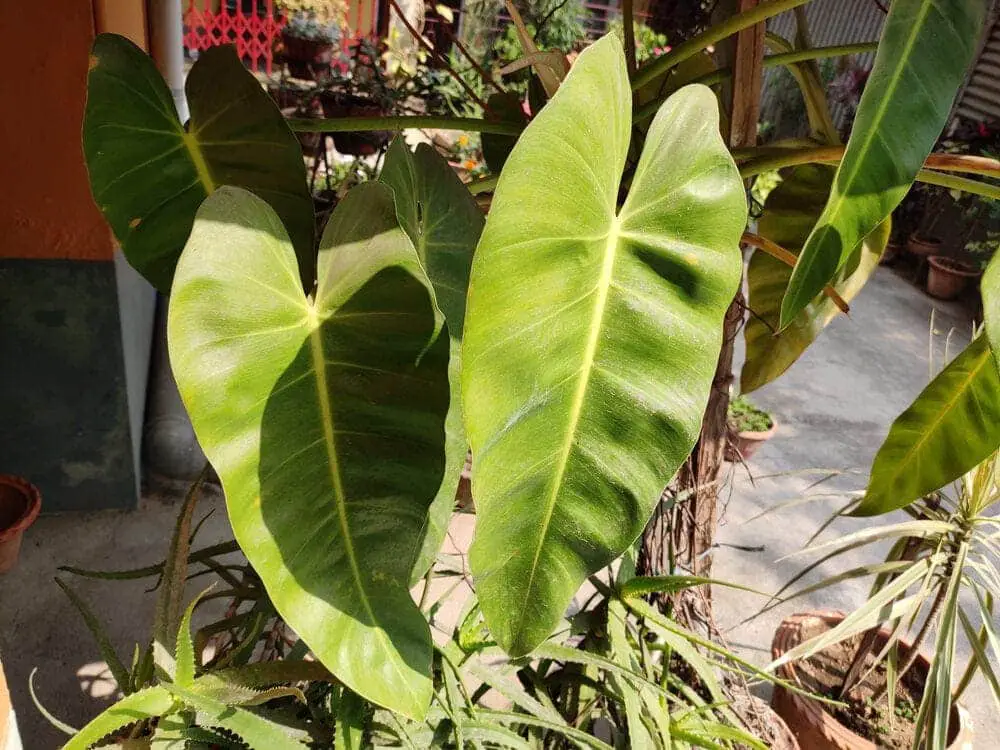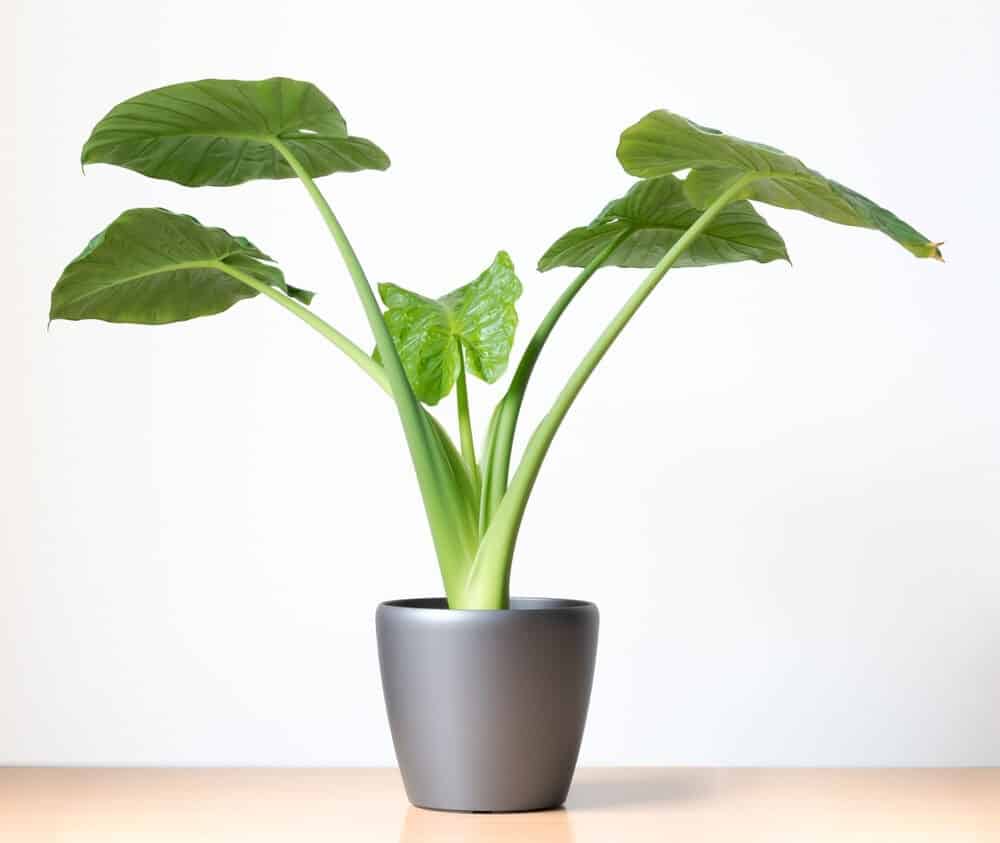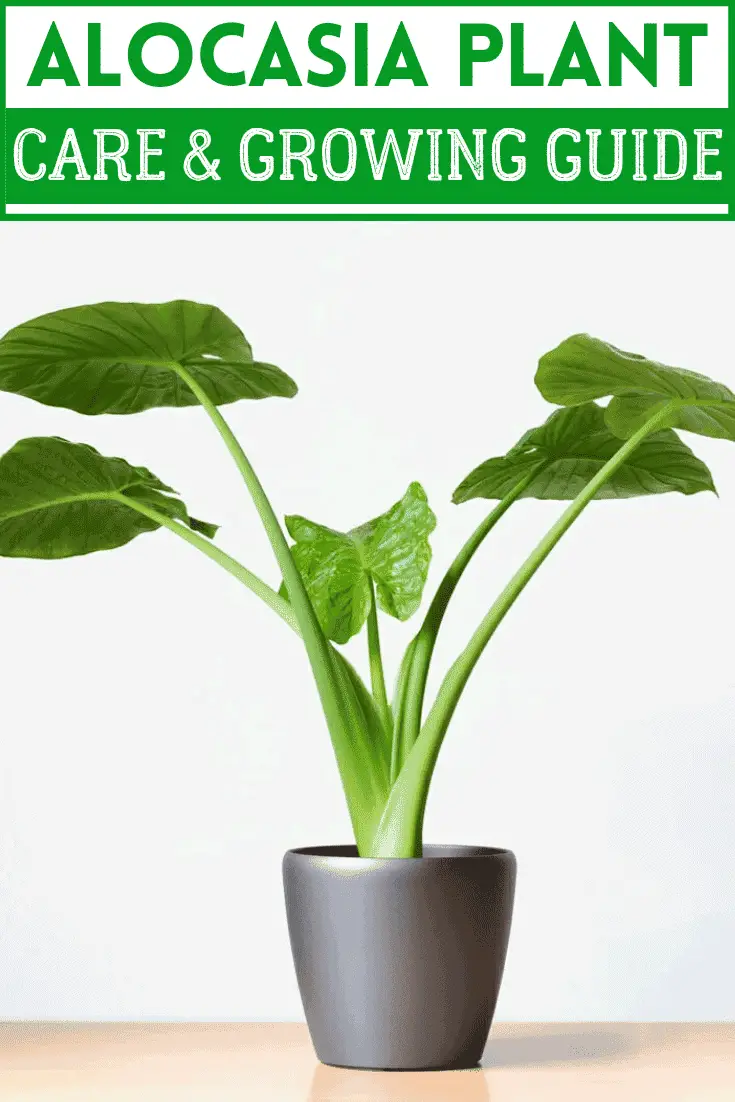The Alocasia tropical plant has stunning foliage that can easily become a centerpiece of your garden or any room.
The Alocasia plant is also known as Elephant Ears or African Mask. Some feel that this plant is sensitive. When you grow them indoors you are going to need a large pot as they grow quite large.
Alocasia Plant Care & Growing Guide
1. Light Requirement
The Alocasia plant needs indirect, bright light but it can also go from full sunlight to shade. It all depends on which variety it is. When you buy your Alocasia plant, ask the grower if it is sun-trained because, with more light, the leaf color will be better. They do best with morning sunlight and afternoon shade.
2. Water
Before you water your Alocasia plant, let the top few inches of the soil become almost dry before you water it. If you let the plant sit in soggy soil, it will make it susceptible to fungal infections. The Alocasia plants are water-loving plants so make sure that you keep them moist all year but not soggy. During the winter months when the plant is dormant, it will need less water.
3. Climate
USDA Hardiness Zone 10-11 for the plants grown outdoors
4. Soil
The soil should be well-draining and lose, such as crumbly loam or potting mix. The soil pH should be 5.5-6.5. The larger specimens of the Alocasia plant are heavy feeders so during the growing season, feed them liquid fertilizer. You could also use small frequent applications of granule fertilizer. Before you plant your Alocasia plant, you should work two to four inches of compost into the soil. This will help your soil retain moisture while giving the plant organic matter.
5. Temperature
If the temperature gets below 60 degrees Fahrenheit, the plant will start to suffer. During the cold months, some varieties will die back and then resprout from the rhizome, which is the underground stem. The Alocasia plant thrives better in humid environments so to raise the humidity around your plant, put it on a tray that is filled with pebbles. Add some water until it rises to just below the bottom of your pot.
Make sure that you keep them from drafts and air conditioning. The idea temperature would be 65-80 degrees Fahrenheit.

6. Repotting
You should repot your Alocasia plant every year into a larger pot with new, free-draining potting soil. To keep the plant to a reasonable size, divide the rhizome when you repot it. It will also increase your collection of Alocasia plants.
7. Speed of Growth
In the warm summer months during the growing season, they can produce a new leaf each week and the leaf may be twice the size of the one grown the previous week. In the late fall and winter, when it is in the dormant phase it will start resting. The growth of the leaf rate will diminish with the plant likely to remain as-is during this resting period. The rapid growth will return the following growing season.
8. Height and Spread
A mature Alocasia plant ranges in sizes from two feet tall and two feet wide to eight feet wide and 15 feet tall. It all depends on the variety of Alocasia plants.
9. Flowers
The flowers of the Alocasia plant are light butter yellow and bloom in the spring and summer. They are coupled with leaves in the shape that vary from wide heart-shapes to slim arrowheads. The veins of the leave are colorful and have textures such as glossy, thick, slick, and waxy. Sometimes the plant will not grow flowers, especially if they are grown indoors.
10. Trimming
When you trim your Alocasia plant, you need to make sure that you quickly remove any leaves that have developed black or brown spots or yellow leaves, which could be a sign of a fungal disease.

Is Alocasia Poisonous?
The leaves of the Alocasia plant are toxic to humans and animals. In the leaves, there are insoluble oxalate crystals and if the leaves are bitten or chewed, the crystals are released. It can cause irritation and swelling of your GI tract and mouth.
Can Alocasia grow in Water?
Yes, you can start your new plant in water and when it starts to root, you need to take it out before it starts to develop root rot. Let it dry a little before you plant it in soil.
How to get Alocasia to Flower?
To get your Alocasia plant to flower or grow more plants, you can do it by rhizome or clump division. Just cut off a piece of the underground rhizome and then you can pot each piece separately. Keep it moist and warm until the new growth starts. Soon you will have new flowers and leaves.
More like this: Rhipsalis Care & Growing Guide
Common Plant Diseases
Alocasia is prone to a variety of diseases, including:
- Leaf spot and Xanthamonas—there are dark brown or black spots on the leaves with a yellowish rim around the spots. This can help to be prevented by keeping the leaves, dry, not over-watering, and making sure there is proper air circulation near and around the plant.
- Mealy bugs, scale, spider mites, and aphids—to help prevent these pests, spray the plant with warm, soapy water every couple of weeks. If you have an infestation you can use a spray of Neem oil or an ultra-fine insecticide.
Also read:
Conclusion
- The northern climates have a shorter growing season but the Alocasia plant is rapidly growing.
- The Alocasia plant has around 70 species.
- The plant is primarily hybridized because of the appeal of its color, leaf form, and sizes.
- The Alocasia plant can be quite sensitive to diseases of the root, stem, and crown.
- The plant is not bought for the flowers but the unique looking leaves.
- Some Alocasia plants like well-drained soil on the drier side while others prefer moist soil.
- One reason that they are called Elephant Ears is that the leaves look like an elephant’s ear.
- If you are planting them outside, make sure that the weather is frost-free.

Victoria is the owner and main author of hobby plants. She loves spending her free time in her garden planting and taking care of her plants. Victoria hopes you enjoy the content here!
![Mother Of Thousands Plant [Complete Plant Care Guide] Mother Of Thousands Plant [Complete Plant Care Guide]](https://www.hobbyplants.com/wp-content/uploads/2022/07/mother-of-thousands-plant-300x158.jpg)
![Majesty Palm Plant Care: [Complete Beginner's Guide] Majesty Palm Plant Care: [Complete Beginner's Guide]](https://www.hobbyplants.com/wp-content/uploads/2022/08/majesty-palm-care-300x158.jpg)
![Exotic Angel Plant Care: [Complete Beginner's Guide] Exotic Angel Plant Care: [Complete Beginner's Guide]](https://www.hobbyplants.com/wp-content/uploads/2022/08/exotic-angel-plant-care-300x158.jpg)
![Snow White Waffle Plant: [Complete Care Guide] Snow White Waffle Plant: [Complete Care Guide]](https://www.hobbyplants.com/wp-content/uploads/2022/08/snow-white-waffle-plant-300x158.jpg)
![Waffle Plant Care: [Complete Beginner's Guide] Waffle Plant Care: [Complete Beginner's Guide]](https://www.hobbyplants.com/wp-content/uploads/2022/08/waffle-plant-300x158.jpg)
![Bird Of Paradise Plant Care: [Complete Beginner's Guide] Bird Of Paradise Plant Care: [Complete Beginner's Guide]](https://www.hobbyplants.com/wp-content/uploads/2022/08/bird-of-paradise-plant-300x158.jpg)
![Purple Passion Plant Care: [Complete Beginner's Guide] Purple Passion Plant Care: [Complete Beginner's Guide]](https://www.hobbyplants.com/wp-content/uploads/2022/08/purple-passion-plant-care-300x158.jpg)
![China Doll Plant Care: [Complete Beginner's Guide] China Doll Plant Care: [Complete Beginner's Guide]](https://www.hobbyplants.com/wp-content/uploads/2022/09/china-doll-plant-care-300x158.jpg)
![Polka Dot Plant Care: [Complete Beginner's Guide] Polka Dot Plant Care: [Complete Beginner's Guide]](https://www.hobbyplants.com/wp-content/uploads/2022/09/polka-dot-plant-300x158.jpg)
![Mona Lisa Lipstick Plant Care: [Complete Beginner's Guide] Mona Lisa Lipstick Plant Care: [Complete Beginner's Guide]](https://www.hobbyplants.com/wp-content/uploads/2022/09/lipstick-plant-mona-lisa-300x158.jpg)
![Yucca Cane Plant Care: [Complete Beginner's Guide] Yucca Cane Plant Care: [Complete Beginner's Guide]](https://www.hobbyplants.com/wp-content/uploads/2022/09/yucca-cane-plant-care-300x158.jpg)
![Bush On Fire Croton Plant Care: [Complete Beginner's Guide] Bush On Fire Croton Plant Care: [Complete Beginner's Guide]](https://www.hobbyplants.com/wp-content/uploads/2022/09/bush-on-fire-croton-300x158.jpg)